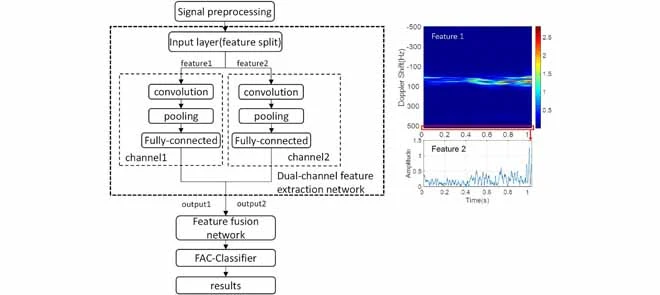False-Alarm-Controllable Radar Detection for Marine Target Based on Multi Features Fusion via CNNs
Moving target detection on the sea for maritime search, surveillance, and security primarily depends on the radar system. However, backscatter from the sea surface, called "sea clutter," severely affects the performance of marine radars even today. In conventional statistical models, the distribution of sea clutter is described and classified based on radar amplitude alone.
Researchers used another feature, the instantaneous velocity change of the target or the scattering points, to differentiate and classify marine targets and sea clutter. The different velocity variations of the target and sea clutter can be reflected on the time-Doppler spectrum using time-frequency analysis. For frequency analysis, linear and nonlinear transforms were employed.
Another significant issue is false alarms due to unwanted targets, such as noise and clutter. An established method for minimizing false alarms is to use a constant false alarm rate (CFAR) detector based on statistical distributions.
Recently developed deep learning methods like convolutional neural networks (CNN) are efficient models for high-dimensional feature extraction. Researchers have extensively applied deep learning models to radar signal processing, gesture recognition, and sea-clutter suppression to achieve reliable target detection and recognition.
The present study proposes a marine target detection system based on marine dual-channel CNN (MDCCNN) coupled with a false-alarm controllable classifier (FACC). The novel dual-channel system utilizes a radar echo's Doppler and amplitude characteristics for feature extraction. The dual-feature extraction significantly enhances radar target detection performance.
The FACC layer uses the support vector machine (SVM) with supervised learning algorithms to detect and control false alarms. A 2C-SVM in the FACC layer achieves false alarm rate control by tuning the penalty factors during the training process. The training model focuses on monitoring the false-positive rate instead of the true-positive rate of target detection.
The detection process comprises three sub-processes. The time-frequency and amplitude information get extracted during the pre-processing data stage. The fusion of features occurs in the fully connected layer of CNN. FACC classifies the data in the next step. An algorithm determines the decision threshold based on the output data of the training set and the required false alarm rate.
The model used intelligent pixel processing radar (IPIX) data and Council for Scientific and Industrial Research (CSIR) data for training and testing. These datasets cover a wide range of mixed sea states and polarization. The neural network takes random dataset samples as input for training purposes.
Experimental results show a 25% better detection probability when false alarms are low. The highest accuracy clocked by MDCCNN was 90.00% and 97.02% on the target sample and clutter sample classifications, respectively. The proposed method achieved a higher detection probability than traditional CFAR-based detectors, with a similar false alarm rate and computational quantity.
The proposed system has the potential for improved performance and the ability to adapt to the complex maritime environment.




